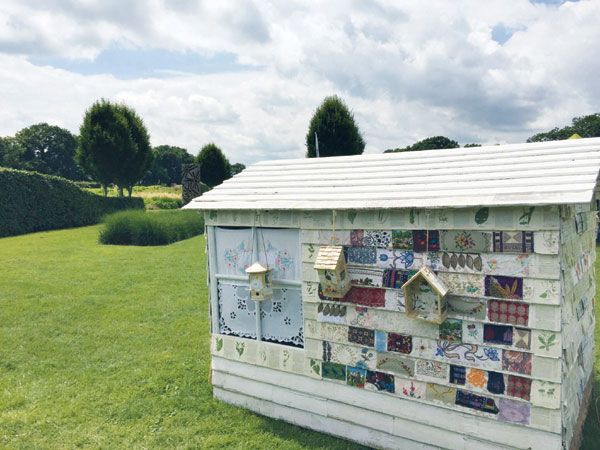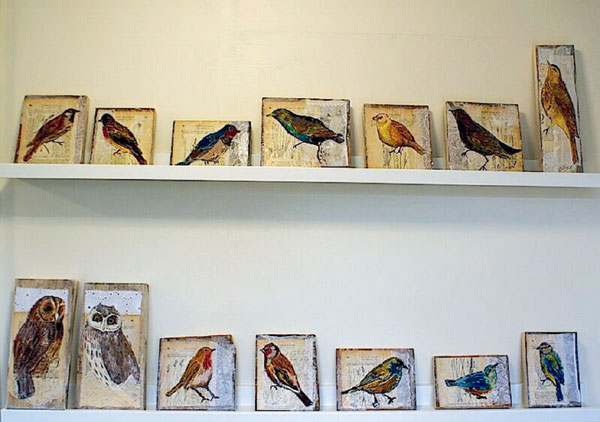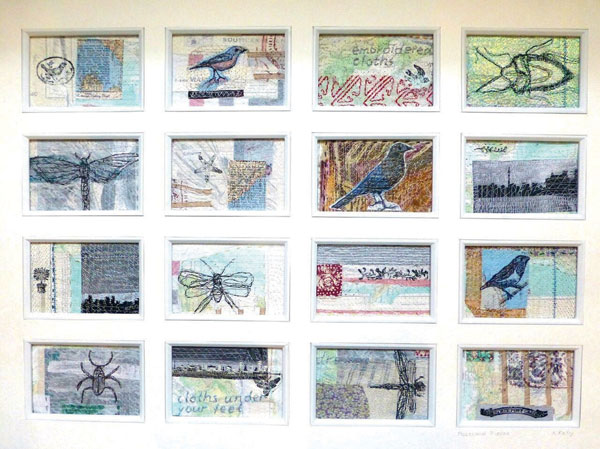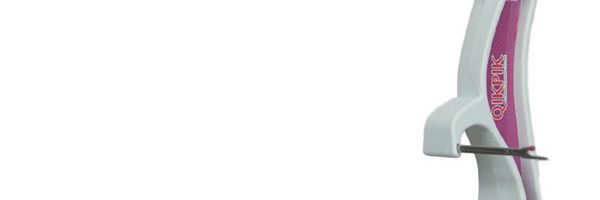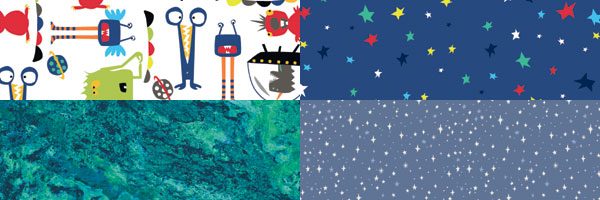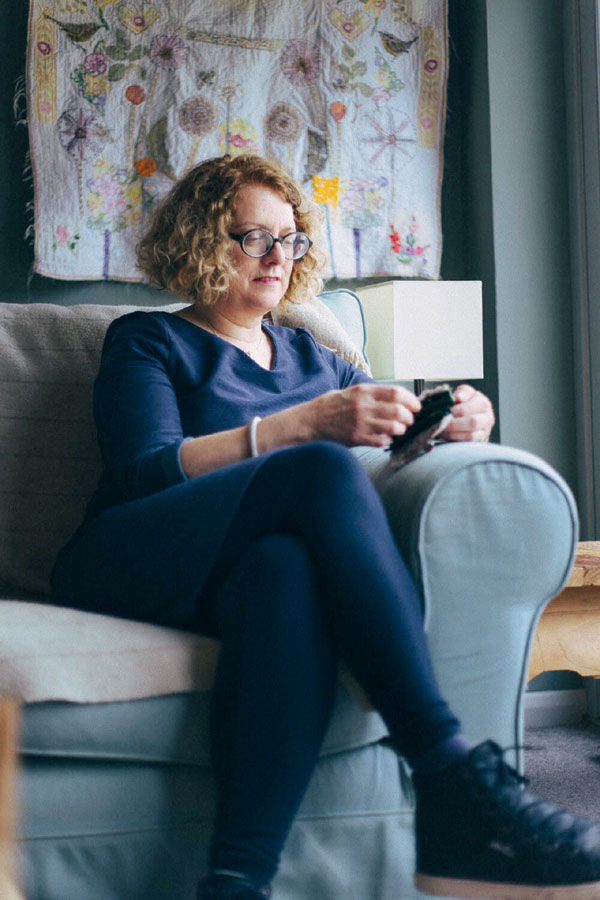
In the Studio with designer Anne Kelly
Anne Kelly’s cloth collages are really something to behold. Here she tells us about her process and what it takes to create such beautiful works of art. By Caroline Adams
Anne Kelly’s cloth collages are works of art in fabric form. She uses layer upon layer of fabric to create scenes of romantic cities, or uses special fabric to celebrate an anniversary, or a collage of fabric made from textiles collected on many travels.
“I would describe my work as ‘layered embroideries’,” explains Anne.. “They are mixed media collages mainly in cloth. The fabric is arranged in layers and then tacked and stitched into place. The whole piece is then overstitched using my signature Bernina edging/finishing stitch. This creates a ‘net like’ appearance to the work and in effect creates a new cloth.”
Anne Kelly grew up in Canada but now resides 56km south-east of London in Kent. She lives in a 125-year-old Victorian townhouse with a shed serving as a studio in the back garden. This friendly neighbourhood, which is still near to large towns and amenities, enables Anne to enjoy walks and holidays in the countryside, which inspires her work.
“We are at the top of the hill and have views across the town from upstairs,” describes Anne. “My garden formed the basis and subject matter for my first exhibited pieces and is an integral part of my practice. I often sketch parts of it for inspiration and starting points if I am stuck.”
Growing up in Canada, Anne has sewn since she was quite young. Anne’s grandmother was a prolific crafter and made everything from quilts and lace to rug hooking. “My mother was not interested in domestic work of any sort, but had the foresight to send me on a beginners quilting course when I was a bored young teenager. I loved it and have never stopped stitching since!”
Don’t stop stitching with the Petit Amour Sewing Accessories pattern
Anne then completed a Fine Arts degree in Canada and took on further training at Goldsmiths College in London. “After my degree in Canada I gained two consecutive Elizabeth Greenshields Foundation awards to travel and work in the UK. I have taught and worked in the arts for more than 30 years and came back to textiles through my teaching. I started exhibiting locally and encouraged by feedback, sales and commissions, began to vary the size and complexity of my work. As the work grew in scale, the techniques I used to make it adapted accordingly,” explains Anne.
Throughout her career, Anne has worked closely with several artists, writers and makers, producing exhibitions, small books and articles. The best-documented collaboration was with Cas Holmes and their book Connected Cloth. This book charted the processes they used for a very successful collaborative process, culminating in a joint exhibition at the Prague Patchwork Meeting.
Talking of her own process and how she starts projects, Anne says, “I start in a variety of ways. Often it is a single fragment of fabric that can inspire a whole piece. I work from sketch books, which are always ongoing, and use photography for my research. I will do a full-scale drawing to gauge the size and shape of the piece. I can then reproduce this and use the copy as a template to cut out textile pieces. I start by creating a rich and complex background to which other pieces can be added. When the main structure is in place, I overstitch the piece. Then I use free-motion embroidery to outline and emphasise key shapes and to add text. I use ribbons and hand stitching to complete the piece.”
Vintage domestic textiles, such as cotton, linen, lace plus patchwork and embroidery are all present in Anne’s work. She uses old handkerchiefs, table napkins, tablecloths and tray cloths as base materials for her work.
“I use scraps of ethnic embroidery from a variety of countries as extra embellishment in my work, if appropriate. I like to use translucent panels of lace and organza to layer into the pieces. They act as ‘filters’ for the viewer and help to push back or emphasise aspects of the composition. I particularly love old printed fabric as it is soft, easy to print on and very durable,” details Anne.
She insists she would not describe herself as an “eco warrior” but does like to recycle fabric as she believes it’s a shame to see old unwanted pieces of work in charity shops or going to landfill. She encourages her students to use pieces they have at home that aren’t too precious, as they will do something amazing with it. “I love it when they repair, replace and reform their old pieces with new elements. I don’t dye many large pieces of fabric but use it like paint to colour areas of work which need a colour change.”
In terms of tools, Anne loves her Bernina sewing machine as it enables her to stitch through several layers of fabric and make an almost tapestry-like new textile. She favours the older machines, which were made in Switzerland and have a metal body, as they are heavy duty and enable her to layer more. Her free-motion foot and sketchbooks allow her to draw with stitches, which is essential to her work. Anne also loves block and screen-printing and uses a variety of wooden blocks donated and purchased from exhibitions and travels.
Make your own Pineapple Block Cushion
Anne’s work has developed from predominantly mixed media on paper and board to mixed media textile. She utilises the skills from her Fine Arts training with new processes, which has been a gradual and enjoyable journey.
“When I started making my first layered textile pieces more than 15 years ago, I felt that I finally discovered the technique that suited me best. Artists need to be adaptable and as the scale of my work has changed, the techniques I use to create it have been modified to fit these larger and more complex pieces,” Anne says.
She draws inspiration from the world around her. In Canada she was fortunate to have an abundance of beautiful landscapes wherever she looked. “It is the details that interest me and I now have a modest town garden in Kent which favours some beautiful flowering shrubs and trees; they are my inspiration for shapes, patterns and subject matter. Much of my recent book, Textile Nature, describes how I use what is around me as starting points,” she explains.
Like most of us, Anne does try to keep her fabric stash under control, however it is a constant battle. “I sort my fabrics into big plastic boxes according to fabric types such as domestic linens, embroidered samples, cottons and linens, and plain canvas and linen union for larger pieces. I have several large embroidered tablecloths that I use for backing cloths or backgrounds. I have some which I just admire and never get around to using!”
Anne has converted a large shed-like outbuilding in her garden into her studio. It is solid and has a work bench running through it. She uses it all year and loves being in it. Her much-loved thread collection is stored in Chinese-painted boxes given to her by her daughter-in-law and Bernina sewing machine takes pride of place. Anne opens the studio as a gallery each June for South East Open Studios and it has been a wonderful venue to welcome visitors from near and far.
A typical day for Anne starts with a swim at the local pool, and the walk there and back gives her time to clear her head. “After a cup of coffee I will attack the inbox and start working. I try to designate at least one day a week as a creative stitching day in the studio, as all the admin, writing and teaching can take over, as much as I love it!” reveals Anne. “I stop for lunch and then continue working until dinner time. I generally hand stitch in the evening as I find it relaxing. My days vary a lot depending on whether I am travelling or not.”
Create a striking Australian Spirit Art quilt
Anne recently visited Australia for the first time and was overwhelmed by the generosity and creativity she found. She was invited by Fibre Arts Australia and held some workshops in Sale and Ballarat, along with workshops for Timeless Textiles and the Berry Quilting Retreat. “I developed some of my Op Shop finds into pieces and contributed some work to the Stitched Up exhibition at the Timeless Textiles Gallery in Newcastle. I was bowled over and very inspired by the beauty and variety of the landscape — and despite seeing a baby Huntsman spider, I am hoping to return in 2019!”
Anne’s diary for 2018 is filling up fast and she will be holding classes and talks at many venues in the UK and Europe, along with organising work for two international exhibitions in 2019. She is enjoying the travel and meeting and working with students around the world.
Currently Anne is working on a new book, Textile Folk Art, due out in 2018, and was very much influenced by the folk art tradition of her native Quebec and New England. “I love the simplicity and honesty of folk-inspired work and hope that this will come across in the book.”

